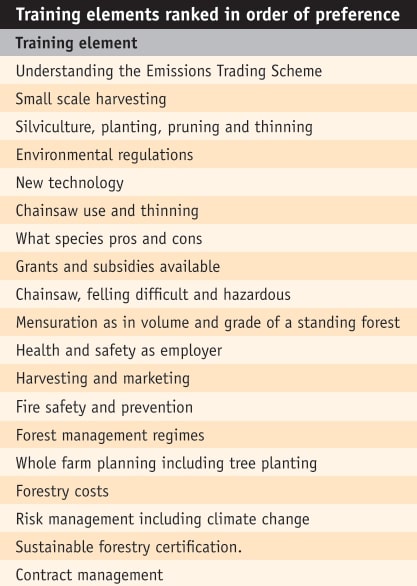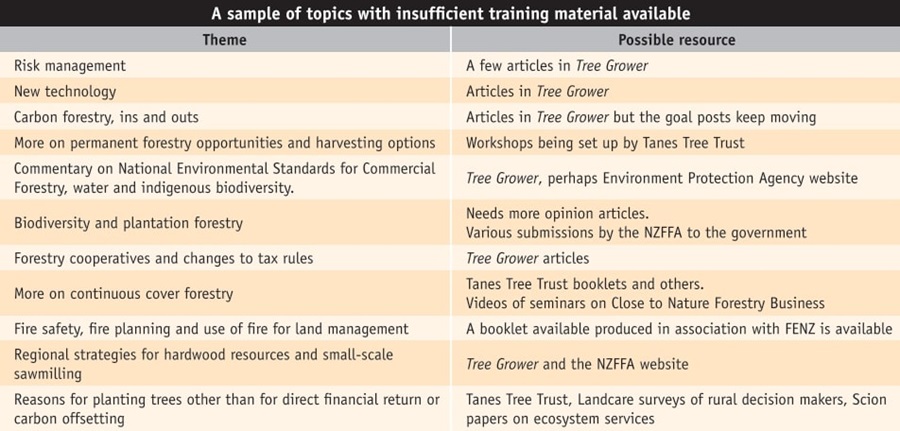
This is free.
The training needs of small-scale forest owners
Eric Cairns and Julian Bateson, New Zealand Tree Grower February 2024.
An on-line survey was made available between April and June 2023. Although only a small proportion of the small-scale forest owner sector were prepared to respond to the survey, there was a total of 143 responses.Where data could be compared, results are not dissimilar to a larger survey carried out in 2015.
Not always experts
Small-scale forest owners are significant overall contributors to the forestry sector. Around 16,000 of them currently provide about 40 per cent of the Forest Growers’ Levy income.This is despite the fact that their businesses are usually a sideline and intermittent, that many of them have no professional forestry qualifications and that few are affiliated to any forestry organisation.
Forestry training courses offered by Competenz Te Pukenga and Canterbury University are aimed at people working in forestry full time. Little is offered to forest owners whose primary business is in a totally different area, but who want to run profitable part-time ventures growing and harvesting trees.
Although larger scale operators in the sector are more likely to employ the services of professionals, particularly for harvesting and marketing, many owners of small forests do not get professional advice.They would rather make their own decisions concerning forestry planning, establishment, management and harvesting, changing technology, legislation and compliance along with new market opportunities.They do not need to be experts in all these areas, nor do they need the physical skills to do every job, but they do need to understand the terminology, the risks and the paperwork involved in meeting their obligations and in contracting people to carry out the physical work safely.
A major part of this project was to refine and produce an inventory of existing training resources suited to small-scale forest owners and review the training available for its currency, accessibility, depth and relevance.
Survey results
Some significant points from the results are –
- A total of 60 per cent of respondents were over 60 years old and a third between 40 and 60 years old
- Almost 90 per cent were owners, a third managers, along with a mixture of shareholders, family beneficiaries and employees
- On property size, just over 10 per cent had forests under four hectares, a quarter had between four and 20 hectares, 40 per cent had forests in the 21 to 100-hectare range, and 25 per cent over 100 hectares.
- Most responders, 95 per cent, were affiliated to the NZFFA
- A total of 70 per cent self-rated themselves with low to medium knowledge and experience with forestry, and 30 per cent with high knowledge.
- The most common topic to seek professional advice was for harvesting, followed by the Emissions Trading Scheme and marketing.
Topic prompts for training needs were divided into three groups of questions, practical, business and regulations.
The table below ranks the combined topics in order of preference.
On the preferred way to access learning, 70 per cent preferred local workshops and field events, nearly half wanted a mix of practical and self-paced, with a similar proportion wanting to connect with others in their area who had done similar in discussion groups. Regarding the importance of gaining a qualification, 80 per cent said the knowledge was sufficient. No one rated a qualification or certificate alone as the most important factor.
In addition to running an on-line survey, we compiled indirect information from attendees at Mystery Creek and farmers attending a series of Te Uru Rakau – NZ Forest Service extension workshops run by the NZFFA for basic information about trees on farms.
The main areas of questions covered the following.
- Alternative species
- Emissions Trading Scheme
- Native tree afforestation
For people without extensive experience in tree growing or forestry, it might have been difficult for them to volunteer detailed information about their training need because they did not know enough to ask themselves the right questions.‘They don’t know what they don’t know’. By contrast, our on-line survey prompted responses for a range of topics in business, practical skills and regulatory compliance.
Training preference topics
Some chainsaw courses are available from regional trainers. Local branches of the NZFFA or land user groups could arrange training courses for their areas. Some trainers may offer a discount if a registered qualification or micro-credential is not required.
Small-scale harvesting has been addressed by Tree Grower articles with examples of how various blocks of trees were sold. Harvesting in forests larger than one hectare is required to comply with the National Environmental Standards for Commercial Forestry, a range of notification requirements and as well as possible consents from local or regional authorities.
We would not encourage amateur foresters to physically harvest their own forests. In addition, where a harvest is large enough to require notification,Worksafe will require evidence of training and safe work practices. There are booklets and feature articles on continuous cover forestry such as totara harvesting in Northland.

Risk management including climate change
The idea of this topic was about risk in terms of financial returns. However, it could equally apply to environmental and social outcomes enhancing or degrading ecosystem services, changes in biodiversity, or gain or loss of carbon, positive or negative effects on the community, public licence to operate.
Risk factors which might affect economic return and therefore willingness to invest in forestry include –
- Long term nature of forestry investment.
- Choice of species and management regime.
- Changes to cost of capital
- Changes to land values.
Risk factors which could affect environmental and social outcomes might include –
- Health and safety within the wider industry
- Extreme weather compounded by climate change including fire, storm, droughts, floods and landslides
- Adverse downstream effects on communities after floods
- Resilience of cultivated species to withstand changing climate
- Changes to environmental regulations including management of biodiversity within or nearby plantation forests.
On-line resources
There is insufficient space in this article to name all the sources of on-line information. However, most of the major organisations connected to forestry, pastoral use, climate change and health and safety have useful websites.The larger ones tend to cater for their own in-house audience.These include Beef and Lamb, the dairy industry, NZ Forest Owners Association, Forest Growers Research, Scion, Forest Industry Contractors Association, Forest Industry Safety Council, Agmatters, Landcare,Worksafe,Tanes Tree Trust, the NZFFA and the NZ Journal of Forestry.There are various forestry management companies who provide newsletter services and digital magazines such as Friday Offcuts and NZ Logger magazine.
A few websites are more generalised and so tend to provide introductory level information. An example is Canopy which provides basic information about forestry as well as useful links to articles with more detail that are hosted by other websites.The Canopy links to additional information are by no means complete.
Most of those who read Tree Grower are members of NZFFA and our own website is one of the largest, with over 8,000 pages of useful information. Most of you will agree that the website is not easy to navigate, and you need to know what key words to ask the search engine. The tree selection tool, for example, is buried in the library.The links to Forest Growers Research are very helpful and give access to many research reports which the public cannot find via the ‘front door’.The table below shows some areas considered to have insufficient or inadequate training material available.

Potential training providers
Training for hazardous activities, especially in relation to chainsaw use, need to be provided by Competenz- certified trainers and assessors. In many situations a formal recognition of achievement, such as an achieved unit standard, is desirable for health and safety reasons, Worksafe compliance or as a pre-requisite for further study. A combination of several unit standards can add up to micro credentials or broader qualifications. Several training organisations, both within polytechnics and private providers can provide this training.
The polytechnics tend to offer a mix of attending courses along with work-based learning aimed at industry employees, not part-time or amateur foresters. Private trainers can run short courses at a local level. Polytechnics offer a range of qualifications predominantly aimed at those intending to work full time in the industry.There are narrow scope micro- credentials available for planting, forestry environment, and basic chainsaw use in production and non- production forestry.
Non-hazardous areas
For the non-hazardous work, secondary schools, polytechnics, private training providers and universities do not offer suitable forestry related modules which are pitched to the needs of small-scale forest owners in terms of level of complexity, course length and availability off campus. In these less hazardous activities, such as practical silviculture or business related and regulatory compliance, there is less need for certificates of achievement or a qualification, so these activities might be considered as out of scope for the polytechnics and Canterbury University
It therefore falls to organisations such as the NZFFA with branch field days or workshops and on-line resources to fill the gaps. Potentially short courses for the practical basics of planning, tree planting and silviculture could be run for land user groups, depending on demand.
Were course work and information to be provided for a fee, those carrying out the work may need to be registered and approved as forestry consultants.The non- practical components of running a forestry business are mostly available on-line, but not in a systematic way.
In the 1990s Bruce Treeby of the Open Polytechnic used to offer non-qualification courses in farm forestry and tree cropping.These provided feedback and were popular. No such courses are presently available in New Zealand.
Recommendations
After carrying out our surveys, the NZFFA still considers that small-scale forest owners need access to technical and operational information in sufficient detail to support their decision making.The NZFFA is advocating for a series of short modules with self-directed learning which could be obtained on-line, but do not result in formal qualifications.
There is also a clear need for more basic information for those new to managing trees on farms.The Canopy website is good at providing that basic information.
Some of this information could also in the form of workshops or seminars with on-line videos.
Manual skills training for hazardous activities, such as chainsaw use, high pruning, tree felling and land clearance or felling difficult trees, obviously need practical sessions run by qualified tutors. Individual unit standards or micro credentials are available for chainsaw work.
The recommendations are as follows –
- That more specialist information from the NZFFA website be made accessible from Canopy, a perceived unbiased provider.
- That the NZFFA website be made more accessible for information and resources allocated to keep it more up to date and more user friendly.
- Of the broad themes shown in the table, new technology and risk management are the main areas with a deficit of information.
- To address the information gaps where we believe that insufficient training material is available.
- That practical training for safe use of chainsaws be promoted for all rural land users. In particular, to teach aspects of risk assessment and knowing when your own skills and equipment are inadequate for the task.
- There is an opportunity to create a structured non-qualification ‘small scale forest owners woodlot training course’ similar to one that used to operate from the Open Polytechnic in the 1990s. Financial assistance for a technical writer and moderator would be required.
This article summarises the full report and survey results.
Eric Cairns is on the Forest Growers’ Levy Training and Careers Committee where he represents small-scale forest growers.
 Farm Forestry New Zealand
Farm Forestry New Zealand